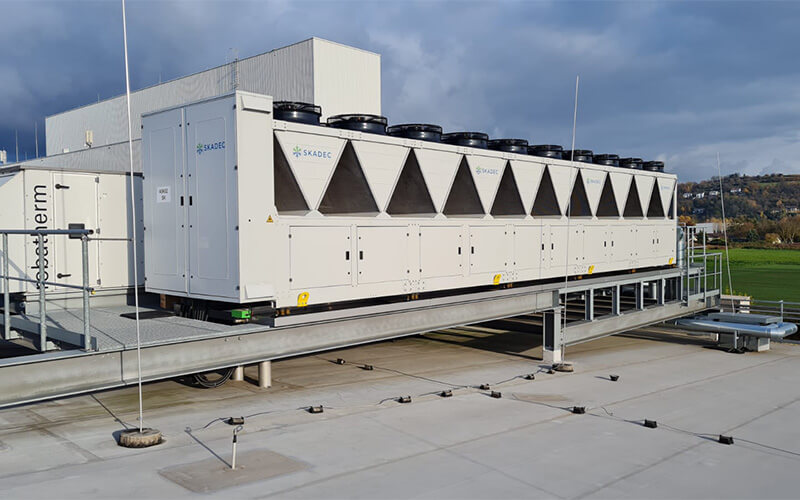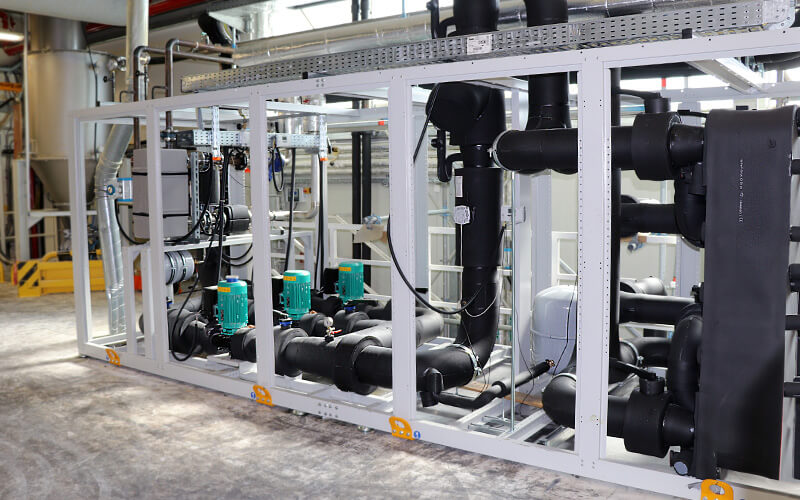Propane: No problem in the adhesives industry
The flammability of natural refrigerants continues to make many refrigeration system manufacturers and operators shy away from propane. The following project, in which an adhesives manufacturer purchased two refrigeration systems with R290, shows that there is another way.
R290 – FUTURE-PROOF PROCESS COOLING FOR ADHESIVE MANUFACTURERS
At the turn of the year 2019/2020, the chemical company Kleiberit Klebstoffe GmbH from Weingarten near Karlsruhe decided to invest in new, future-proof and environmentally friendly refrigeration technology. The decisive factors for the investment were the failure-prone refrigeration systems in the existing building and the desire for a long-term alternative to HFC refrigerants. In particular, the high refrigerant charge of the existing water chiller with externally installed condensers was a long-term financial risk due to the increased price of HFC refrigerants. The question of their availability in the coming years and environmental concerns also underpinned the choice of a refrigeration system with natural refrigerants.
OPTING FOR R290 IN FUTURE
Following advice from Skadec GmbH, Waldenburg, the chemical specialist decided in favour of R290 (propane). This natural refrigerant is characterised in particular by its high energy efficiency, low pressure level and simple system handling during operation. Compared to HFO and HFC refrigerants, propane occurs naturally in the atmosphere. It therefore poses no risk to the environment. Compared to other natural refrigerants, R290 water chillers are favourable in terms of purchase, operating and maintenance costs.
PLANT ENGINEERING
Due to the individual requirements for the new refrigeration technology, the adhesives manufacturer opted for externally installed air-cooled water chillers. Even in the early project phase, it became clear that, in addition to system safety and efficiency, maximum flexibility should also be prioritised. An initial system design with two separate cooling circuits and two screw compressors was therefore rejected, as the low cooling partial load requirement of the downstream processes could only be mapped poorly. A system concept was then developed in collaboration with Kleiberit that fulfils all of the adhesive manufacturer’s requirements without compromise. The concept: to install two water chillers with 800 and 500 kW.
WATER COOLING UNITS
An air-cooled water chiller with five reciprocating compressors, five separate refrigeration circuits and 20 EC fans (four per refrigeration circuit) was designed to provide 800 kW of cooling capacity. One refrigeration circuit with a guide compressor was equipped with a frequency converter. In addition, all other compressors have four-stage capacity control, enabling a continuous cooling capacity of 40 to 800 kW. The large air-cooled microchannel heat exchangers, which are designed to maximise energy efficiency, guarantee a delta T < 10 K between the ambient and condensing temperatures. To further increase energy efficiency, the water chiller has a 168 kW heat recovery system (flow temperature 65 °C). Another special feature of the machine is the system-side connection of the five separate plate heat exchangers within the machine using welded stainless steel pipework. The second R290 water chiller with 500 kW cooling capacity has three separate cooling circuits, twelve EC fans and six reciprocating compressors for reasons of operational safety and low load reduction in partial load operation. The lead compressor in each refrigeration circuit is frequency-controlled, enabling infinitely variable capacity control from 37 to 500 kW. An 80 kW heat recovery system (flow temperature 65 °C) was also installed here. The chillers were each designed for an ambient temperature of 37 °C instead of the usual 35 °C ambient temperature.
CONTROL
Both chillers have a programmable logic controller (PLC) that can easily map the individual system configuration. Compared to compact controllers, customised project-related PLC programming offers extensive advantages for operators, manufacturers and service technicians. In the case of a chiller and especially in the event of faults in a system, it is advantageous to be able to understand the operating behaviour in detail. An intuitive operating concept makes it possible to save time when servicing on site and to quickly locate faults and change the settings. The touch displays attached to the control cabinet of the machines visualise the entire water chiller set with all operating values of the individual cooling circuits, which are displayed with a coloured background depending on the operating status (see Figure 2). This allows the user to navigate quickly and accurately. The service managers in the office can connect to the system remotely and see the same visualisation as the service technician on site at the customer’s premises, allowing them to provide optimum support. A powerful data logger on the PLC saves more than 60 process values every 5 seconds over a period of more than ten years. The data recorded in this way can be quickly and easily graphically displayed and analysed using a web server integrated on the PLC. This makes it possible to evaluate the operating behaviour of the machine or narrow down possible causes of faults before a service technician arrives. This can significantly reduce the service time at the customer’s premises. In addition, settings can be easily adjusted and programme updates installed via a VPN connection. The connection to the internet is made via LTE.
HYDRAULIC CONNECTION
Another challenge was connecting the new refrigeration technology to the existing network. The connection was made during ongoing operation, which meant that only a brief outage of the cooling supply could be tolerated and the space available was correspondingly tight. In addition, welding work in the building was only possible under special conditions. As a solution, two customised and compact hydraulic modules were developed in collaboration with Kleiberit. These were prefabricated in the factory and enabled on-site installation to be reduced to a minimum. The modules each contain the system separation in the form of plate heat exchangers, redundant pump groups for the cooling supply and one pump each for heat recovery. The modules, like the hydraulics of the water chillers, were completely piped in welded chrome-nickel steel (V2A). For the primary cooling supply, the large hydraulic module comprises three frequency-controlled high-efficiency pumps, whereby two pumps always guarantee 100% flow and one pump serves as a reserve. The individual modules are completely controlled and regulated via the PLC of the associated chillers. This meant that two additional control units were not required.
SAFETY ENGINEERING
Due to the flammability of propane (A3 refrigerant), a special risk assessment and risk management was required. Access to the chillers is restricted and only possible for trained personnel. Furthermore, a propane gas sensor is installed in each water chiller, which de-energises the system via two switching stages. The EX-protected system components are supplied via a separate supply line. An integrated EX fan ventilates the housing and guarantees that no flammable mixture can form. Any faults that occur are forwarded directly to the higher-level building management system.
CONCLUSION
Switching from HFC to natural refrigerants is always a challenge. However, there is almost no application today where natural refrigerants cannot be used. Their use saves money in the long term and is good for the environment.
BAFA FUNDING (only available for projects located in Germany)
The two installed systems are separate production processes that are not connected in terms of refrigeration technology or on the process side. This made it possible to submit separate BAFA funding applications for both projects, which had a positive effect on the amount of funding. The amount of funding for both projects totalled €108,792 (€60,167 and €48,625).
Our BAFA calculator will help you to calculate your subsidy.



